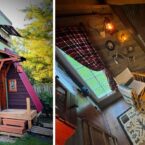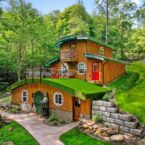The internet is filled with DIY projects that involve the use of cheap materials, like plastic bottles. People have come a great length in the struggle for a healthier planet, in the last 20 years. Recycling is not only a trend but a necessity nowadays. And fortunately it has become a healthy habit.
First thing you need to know about building a greenhouse out of PET bottles is you ought to enjoy working with plastic. The trick is you actually build each `wall` at a time, although in total it seems you’re dealing with some kind of a castle, involving almost a thousand bottles in order to raise-up a 2 by 2 by 2 meters structure. Here is a effective advice to beginning the process: measure your bottles. Doing so, the frame will be exactly of the necessary size. If there is however any miscalculations, you could easily cut some of the height of the bottles. Then it’s all about cutting and gluing the bottles between them and to the wood frame. Work on the wooden frame placed flat on the floor. Make sure you have a couple of pieces of wood positioned underneath the frame; this way, the bottles will be centered to the middle of the frame and not bulking in any other way. Pour a bit of silicon in between the bottles once the wall is done. Do the same with each `wall`. And remember to put in a flap panel for use as ventilation. You could also try the more futuristic round greenhouse structure. There is much to do. We’ll leave you to it.

















How is it that you attached all the bottles. Can you give a little more detail as to how you did this?
Regards,
Randy Comeau
Getting There Green
youtube.com/gettingtheregreen
ana-white.com/2011/04/plastic-bottle-green-house-build-guide
@Marilyn your link doesn’t work right now.
http://www.reapscotland.org.uk/wp-content/uploads/2011/04/Plastic_Bottle_Greenhouse_Instructions_2004.pdf
you cut the bottles at the bottom making them interlocking/modular .. like leggo pieces and if you have lets say pvc pipe or bamboo shoots long enough .. run them through the neck opening for a more sturdy structure…
It would be cool if u could use bamboo shoots but let them keep growing, so that it’s kinda like a living greenhouse.
Hola podes descargarte de internet que hay un manual de INTA donde describe como hacerlo
Look under the last picture, there are 2 sentences ending in “, you will need these materials” with “these materials” in blue. It’s a link to a website with better directions.
Often (but not always) the blue words in a sentence are a “hyperlink” to another site or location.
reapscotland.org.uk/wp-content/uploads/2011/04/Plastic_Bottle_Greenhouse_Instructions_2004.pdf
if you click the “these material” tab at bottom of page it takes you to a link showing you everything
That’s a great idea. Unfortunately, no project for Germany. We pay 25 cents deposit for each bottle. That would be a very expensive project. Too bad.
Paying a 25 cents deposit for every bottle is one of the good ways to get back to a healthier planet. Germany is a good example for us all.
You mean FORTUNATELY you have to pay a deposit in Germany; as with a lot of things, Germany is way ahead of the rest of us, and you should be glad, there is already too much plastic going around on this planet; I’m sure there are other ways of still getting that recycled greenhouse for you 😉 BUt I understand the disappointment, It’s a nice project 🙂
Michigan has had a .10 deposit for at least 30 years. All states should!!
But, we only have a 10 cent deposit on carbonated drinks like soda pop and carbonated water. Anything else – like plain water or juice – have no deposit :/ sigh, I don’t drink soda but I do drink bottled water, this project is good for me. Especially since I live in an area of MI that doesn’t have a recycling center anywhere near close by. . .
NY has a 5 cent deposit (I used to own a Redemption Center) and they now include the water bottles (finally). Yes, every state should have a deposit on bottles. NY still does not have deposit on juice cans or ice tea and tomato juice cans.
Redemption Centers give people jobs that don’t need a high school diploma and it keeps the state cleaner. Reuse, recycle, reduce.
Check the ocean there is a as land floating the size of Texas out there…go get it and start there.
In Michigan, USA, not all bottles are refundable for money. Only those drinks which are carbonated. So you could use water, juice, sport drink bottles or pretty much any kind of bottle of similar sizes to create a wall.
Germany uses glass for most of their bottles. We were there last October and everything was in glass. What’s frustrating is that they don’t recycle paper. And there aren’t places where the average person can deposit stuff to recycle (like cans, newspaper, etc.). Some things about Germany were awesome; other things could use improvement. Like everywhere else.
That’s not the whole truth 😉
Germans prefer to drink beer from glas bottles, some water too, but usually plastic bottles (although not so healthy, but not so heavy) with 25 cent deposit, also for cans. Every supermarket has a machine for giving back such bottles and cans and yoghurt glasses too. For paper recycling every house gets a so named “Blaue Tonne” for free. It’s also possible to bring it to a recycling company and get back money. Also a “Gelbe Tonne” [yellow refuse bin for the collection of recyclable packaging material, e.g. yoghurt pots, detergent bottles] we have for free. Did I forget anything? 🙂
Do you have a source for the open arch greenhouse image or a link to a tutorial?
no..but i posted a larger.. maybe is more clear now.. thx.
Plastic bottles are toxic, even the bpa free. Loaded with estrogens, etc. This would not be a healthy alternative to grow food in.
don’t be a twat, Tina. This would not be toxic in any way. *eyeroll*
Too funny,true but funny.tell him cow farts are toxic.
You don’t understand chemistry very well.
Well, if you have a high school diploma, then I think it’s safe to say you’ve lost the right to it. Which is sad, because that is one bloody low bar 😛
If only the greenhouse walls were where the plants were going, then you might have had a point. Except, people use pop bottles for individual plant mini-greenhouses all the time; generally for herbs.
The amount of blech in these bottles doesn’t amount to much of anything even on the microscopic level of the particle transfer between bottle and water/soil. Microwaving or heating something within a plastic container can be bad, but the warmth of the sun and the individual plant green house aren’t likely to cause that kind of problem.
Regardless, green house made out of bottles doesn’t hold any plants in them.
The link doesn’t work (nor does the one posted in the comments). Unfortunate. I would love to buy plans to build one of these!
works.. try again please..
Why can’t any of the links you provide actually show close ups of the cutting of the bottles and exactly where they are cut and a close up of them as they go together on the stingers? How does that work? Looks good but needs more clarification. Thanks
Has anyone ever spent a season with one of these? I’m wondering if it wouldn’t be too drafty to contain the warm air produced by the “greenhouse effect.”
It does look like there are gaps between the vertical stacks of bottles, I imagine a chilly winter breeze would make this design impractical. But for strict summer/ warm climate use It looks ok. Though the grass roof one looks to be a warm climate and I imagine it was built to live inside of, So possibly little greenhouse effect at all, though maybe the grass roof changes the effect.
I love the concept and the initiative. But…
I wonder how long until the plastic bottles become brittle and begin cracking. Siliconed in, they would be hard to replace as this happened. And the aesthetics would fade as the clear bottles become cloudy from exposure to the elements.
I’d like to point out the misleading article title. After reading this, I do NOT know how to build a plastic bottle greenhouse.
Agreed.
From the standpoint of recycling correlating to “saving the earth” (which, btw, man cannot do and it is destined to be here for a minimum of another 1007 years beyond each new day), wouldn’t it make more sense to just reuse a single cup or glass rather than continue to buy bottled water? My grandmother kept a long-handled dipper on a nail on the side of the cabinet – everyone used it Well, I suppose the usual and customary response (ahem, excuse) is that our water is too polluted to drink from the tap, and, eww, drink from the same dipper?, so bottled it is. I cannot imagine these structures will last but a season given the power of the sun and other elements, so while they may ‘last’ in that Texas size trash mass, they will become brittle and crack and chip and be a mess on your pristinely saved piece of earth. Sorry for my sarcasm; I just find some of these homesteading/survivalist ideas a bit silly, and the comment even more so. I am also trying to figuring out how all the earth-worshippers fit into the mix.
Thank you.
While I applaud reusing and recycling items as much as possible, if one is serious about lessening one’s footprint it would seem that simply using less would be the best response. Try not to buy any plastic, if it can be helped at all. Find other ways of doing things. Seek out alternatives…especially things that will last you a long time and can have another life doing something else once it’s usefulness has been exhausted.
Take your pick of this information about plastic bottle greenhouse building.
tinyurl.com/mdb5e4l
Lot a questions about this project… First of all, i would be worried about the weather and how long it will last. And what do you use to attach the bottles? Is there some kind of cement or something like that? what if it melts during a very hot day? Has anybody tested this in extreme weather? Wind? Snow? Rain? Thunderstorms? Extremely hot weather like more than 90 degrees?
Just look at the thing to answer a lot of your own questions. They’re plastic, and the frame is as well usually, or metal and wood, so they’ll last night indefinitely. They’re put together by having their bottoms cut off and being fitted to one another like stacks of cups, with the lead necks caught in a vertical guiding/holding tract. As long as everything is well contained within the structure, and the structure bound to it’s location, then it’ll do what any green house would in very similar weather conditions.
I find this very interesting and no reason for others to be annoyed of. This is an idea and its all up to me. I am in the part of the world were buying a green house is very expensive and ideas like these are helpful. If you have another cheaper way of making a green house may you please contact me at ([email protected]). it may help old people and vulnerable groups people here.
How long before the bottles turn green with algae please?
Cut the bottoms off the bottles and put the remaining keeper portions in a bathtub filled with a bleach/water decoction just strong enough to kill anything it comes in contact with. Keep em in there for a minute, pushing them under the water and moving them about. Rinse well, close the structure each stack of bottles makes to airflow and the interior will be, more or less, free from such concerns. The outside can be cleaned with relative ease.
So rather than recycle , you think that sticking the bottles together with toxic silicone and creating more waste with the silicone tubes is environmentally better ??
Give your head and shake . The structures wouldn’t last a strong storm and they would end up in pieces causing more environmental damage . BAD BAD idea !!
So rather than recycle , you think that sticking the bottles together with toxic silicone and creating more waste with the silicone tubes is environmentally better ??
Give your head and shake . The structures wouldn’t last a strong storm and they would end up in pieces causing more environmental damage . BAD BAD idea !! Plus the toxins given off by hot plastic would be dangerous to your health
Thanks Andy. Instead of trying to do something positive, you have pointed out that no matter what we do, we are stupid & doomed. We will find a cave to live in til Andy comes up with a PERFECT answer to all of our problems with his massive intellect. Andy & Tina will be available to Pee on any ideas you might come up with so that we know how Superior their collective smarts are. The Sky is falling Andy, Save Us, Save Us! …….(Waiting for Andy Hammond to give us permission to try to Attempt anything to make our putrid little lives better. Yep, just waiting…….)
I’ve helped with a few of these. They work but it takes a lot of bottle collecting. They are warmer inside, even in the wind, though they don’t keep it all out, but they also let the rain in which is great for watering! Some of the advice here is wrong though. You don’t need to silicone in. The bottles do eventually cloud, but a bigger issue is that threading them on bamboo means water runs through them and then they get algae in them. The better design in my opinion is to create a structure with a sturdy frame of wide planks, then create a tight zig zag of wire on to hold the bottles in on each side of that frame. This allows you to slot the bottles into each other to make a column of bottomless bottles with the top bottle retaining it’s lid topping a bottom one with the top cut off but retaining the base. The wiring method also lets in more light than the bamboo design and it is much easier to replace bottles with this design
If you wanted something a little more sturdy you could find a way to form all of this in and pour the earth itself into the gaps between the bottles. Maybe a circular house tapered to a vent atop. The good news is that with the bottles being cylindrical, the entire house ends up being corrugated.
Bottle houses have been around for long time. Most of the houses that are still standing are made using Glass bottles. With plastic one can do numerous things as casting your walls using clay Adobe style mortar, baked by sunlight until hard like brick with plastic bottles firmly cast in place.
Each wall then becomes a matter of design and placement and structure.
In addition , you can plant expeditiously what ever bottles you want
Maine has a nickel deposit on any type of drinks 10 cents on alcohol.
Think outside of the box… take your bottle, cut the cylinder of the bottle off (remove top and ottom). Now cut the cylinder into a sheet. Repeat and make a big sheet… and apoly it as a wall. Arrange them in a shingle pattern to keep warm air in and water out. Use the tops of the bottles if you can get creative enough to engineer a rain water collection device on the roof as well. Happy greenhousing.
Plastic bottles release dioxin, BPA Bisphenol A, especially when heated by the sun and all of these chemicals has been associated with a whole host of health issues including birth defects, change in hormones, heart problems and cancer. So not a good idea at all to grow and water vegetables and fruits around them…
if you live in a country where you get return for your empty bottles i recon its way cheaper to just buy some plastic
mh.. nah.. thats nothing for me. i lik the idea of reusing plastic, but better than that would be not buying so much plastic stuff.. we should really cut down on using so much plastic..
How is it that you attached all the bottles. Can you give a little more detail
The bottles are stacked on a bamboo stake like a skewer stick. A hole is cut in the bottom of the bottle, or the bottom section of the bottle is cut off. When you have enough bottles cut and cleaned (labels removed and inside of bottle washed) you place the bamboo stake through the opening on the bottom of the bottle, and up through the neck of the bottle. Then the next bottle is placed on top of the 1st bottle and continue stacking until you have enough bottles to fill your space, then you move on to the next row/space using the same method as before. I hope this helps to answer your questions.
In Africa where this is considered an acceptable thing cancer is out of control . “PET BOTTLES” How and who would think this is eco friendly is beyond me. Please do your research folks. PET fibers leach unknown to most (even doctors) toxic elements and poison their surroundings. Why you would want it around you veggies in the hot sun, rain, etc us beyond me. Two words come to my mind when I see this…. Scary disaster. Take a look around our world is made of plastic. So accepted some idiots decided to make medical devices out of them such as Essure (currently being banned) and medical Mesh. Here’s how some of that turned out. Meshmedicaldevicenewsdesk.com most have been left disabled, in excruciating pain, metabolically unstable, with accelerated cancer growths, violent immune issues and some are even dead. Gotta ask yourself if you feel lucky. Because with the right environment it will happen to you. Polypropylene (which most plastic bottles are made out of) for example is being linked to squamous cell carcinona among other things. Do your homework this is just another type of pollution. Sad when those saying their protecting the earth support this type destructive behavior.
Question is why would you want to
Has anyone ever stepped on a bottle that has been out in the sun for while. ? Very brittle. Seems like you would spend more time replacing the ones that fell apart than planting anything in it after the first year. A couple of 2×4’s and some sheet plastic would be a lot quicker and last a lot longer. And considering what Tose said… research.. research.. research
Although there may be many issues with this design in regards to toxin exposure, durability and how well it keeps out the elements one should keep in mind that this was originally an elementary school project. The students were able to think beyond the everyday approach of either throwing the bottles in the trash or recycling them. Hopefully a thorough critique was done on the completed project and these issues were pointed out to the students as part of the learning exercise. Going forward these students will have a different perspective of the world around them and may in the future come up with some truely innovative ideas to improve our world and our lives. For a group of young students I feel they did an outstanding job thinking outside the box.
Oh I just love this post. Amazing piece of content, breath-taking images.
Wanted to write an article about DIY greenhouse but with this kind of ideas who needs more!
Actually if you research it there is no actual ‘trash island’ it’s more like a soup of microscopic pieces of plastic from the litter having been broken down ( degraded)
Yes this will be very beneficial for the environment because we don’t know how much time plastic will take to landfill so recycling and reusing is the best option and for using it for building a home i think it’s far more better idea because it’s cheap and stronger too.
Thank You for sharing this article.
Green houses are made of plastic lol
C’mon peeps- Tina, Andy, Nathalie, Tose especially… we’re not putting this polymer into our bodies or growing our veggies on the plastic. Sure- it’s going to outgas but not as though it was in direct contact.
Psych- why would one want to? Gee… why do you lack the imagination to understand why a greenhouse of recycled materials holds the interest of people? I’m sorry it’s confusing.
Hi there! This is kind of off topic but I need some advice from an established blog. Is it very hard to set up your own blog? I’m not very techincal but I can figure things out pretty fast. I’m thinking about creating my own but I’m not sure where to start. Do you have any tips or suggestions? Cheers
Nice post. I learn something more challenging on different blogs everyday. It will always be stimulating to read content from other writers and practice a little something from their store. I?d prefer to use some with the content on my blog whether you don?t mind. Natually I?ll give you a link on your web blog. Thanks for sharing.
Thanks, Mike, for laying down the science!
Cow belches are worse.
Don’t eat beef, people.
Need instructions please